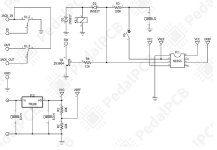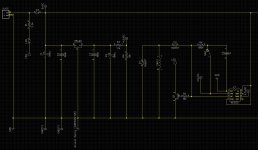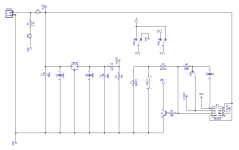Big Monk
Well-known member
I wanted to incorporate relay switching into my Monk Face design.
I chose the Basic Relay Bypass schematic:

I incorporated it directly, making a few changes:

Q1 is a BC547A because that's what I had on hand. Used a 78L05 and adjusted the VRef divider resistors. Added a 100u cap after the regulator.
I soldered in just the components for the switching onto a Monk Face board to test the LED first.
Here is what I am getting:
All solder connections are good. Continuity where required. Voltages seem bang on. Here's what I'm using:
Looks like the dropout voltage is 1.7v.
I'm only using the 4.5v Vref for the relay and it's associated circuitry, i.e. the NE555.
Just checked voltages:
Vref = 4.52v
Vcc = 8.33v
Reg3 = 5.04v
Reg2 = 0v
Reg1 = 8.33v
NE555:
Pin 2/6 = 4.52v
Pin 4/8 = 8.33v
Switch Pin 1 = 4.52v
BC547A (2N3904 sub) collector has continuity with LED -.
I chose the Basic Relay Bypass schematic:

I incorporated it directly, making a few changes:

Q1 is a BC547A because that's what I had on hand. Used a 78L05 and adjusted the VRef divider resistors. Added a 100u cap after the regulator.
I soldered in just the components for the switching onto a Monk Face board to test the LED first.
Here is what I am getting:
All solder connections are good. Continuity where required. Voltages seem bang on. Here's what I'm using:
Looks like the dropout voltage is 1.7v.
I'm only using the 4.5v Vref for the relay and it's associated circuitry, i.e. the NE555.
Just checked voltages:
Vref = 4.52v
Vcc = 8.33v
Reg3 = 5.04v
Reg2 = 0v
Reg1 = 8.33v
NE555:
Pin 2/6 = 4.52v
Pin 4/8 = 8.33v
Switch Pin 1 = 4.52v
BC547A (2N3904 sub) collector has continuity with LED -.
Last edited:


